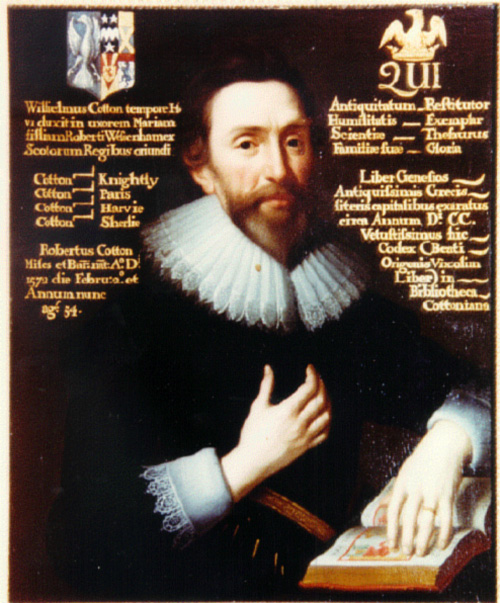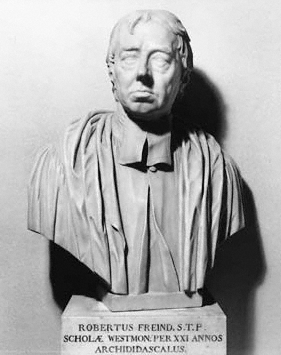- Antiquaries
- Sir Robert Cotton
- Sir William Dugdale
- George Hickes
- Humfrey Wanley
- Thomas Tanner
- Benjamin Thorpe
- Joseph Bosworth
- John Mitchell Kemble
- John Earle
- W. G. Searle
- Walter de Gray Birch
- W. H. Stevenson
- G. B. Grundy
- Hector Munro Chadwick
- Sir Frank Stenton
- Mary Prescott Parsons
- Florence Harmer
- Agnes Jane Robertson
- Dorothy Whitelock
- Richard Drögereit
- Pierre Chaplais
- Nicholas Brooks
- Patrick Wormald
Sir Robert Cotton
Sir Robert Cotton (1571-1631) is commemorated here not least because he assembled the largest single collection of 'original' Anglo-Saxon charters (now in the British Library), and a very considerable number of medieval cartularies (including the two eleventh-century Worcester cartularies in BL Cotton Tiberius A. xiii, and the two versions of the Abingdon chronicle-cartulary in BL Cotton Claudius C. ix and Cotton Claudius B. vi).
Bibl. Colin G. C. Tite, The Manuscript Library of Sir Robert Cotton, Panizzi Lectures 1993 (London, 1994); Sir Robert Cotton as Collector, ed. Christopher J. Wright (London, 1997). See also Carl Berkhout's bibliography of Anglo-Saxon scholars and scholarship.

A portrait of Sir Robert Cotton was commissioned in 1626 by his friend (and fellow collector of Anglo-Saxon charters) Sir Simonds D'Ewes (1st Baronet), of Stowlangtoft, Suffolk. As D'Ewes reported in his diary (written in the 1630s): 'The residue of July [1626] I spent moderatelie well in the studie & discourse of the common law often alsoe intermixing my transcribing of Fleta, the often before-mentioned old law manuscript which I borrowed of Sir Robert Cotton, Englands prime Antiquarie; whose picture downe to the middle I caused this month to bee verie liuelie & exactlie taken being the first & the onlie excellent Representacion that was euer taken of him; & which I now highlie value, & haue placed in my librarie as a select & choice monument'. The portrait, attributed to Cornelius Johnson (1593-1661), shows Cotton with his left hand resting on his prized manuscript of the Book of Genesis (Cotton Otho B. vi), which was all but destroyed in the disastrous fire at Ashburnham House in 1731.
 The portrait of Cotton remained throughout the seventeenth century at Stowlangtoft, and was seen there by Humfrey Wanley in October 1703. It was bought by Wanley from Sir Simonds D'Ewes (3rd Baronet), in 1705-6, and from Wanley by Edward Harley, Lord Oxford, some time thereafter. It was sold at a Harley sale in 1742, and was bought by the antiquary James West (?1704-72). An engraving of the portrait, by George Vertue, was published in 1747 (Vetusta Monumenta I, pl. LXVI). The portrait was sold at a West sale in 1773, and would appear to have been acquired at about this time by a descendant of Sir Robert Cotton. Robert Cotton Trefusis (d. 1778), son of Robert Trefusis and Alice Cotton (daughter of Sir Robert Cotton, younger son of Sir Thomas Cotton [by his second wife Alice], son of Sir Robert Cotton the antiquary), was the father of Robert George William Trefusis, who became 17th Baron Clinton in 1794, and whose eldest son was Robert Cotton St John, 18th Baron Clinton (d. 1832). The portrait is now the property of The Rt. Hon. Lord Clinton, D.L., 22nd Baron Clinton, of Heanton Satchville, Devon.
The portrait of Cotton remained throughout the seventeenth century at Stowlangtoft, and was seen there by Humfrey Wanley in October 1703. It was bought by Wanley from Sir Simonds D'Ewes (3rd Baronet), in 1705-6, and from Wanley by Edward Harley, Lord Oxford, some time thereafter. It was sold at a Harley sale in 1742, and was bought by the antiquary James West (?1704-72). An engraving of the portrait, by George Vertue, was published in 1747 (Vetusta Monumenta I, pl. LXVI). The portrait was sold at a West sale in 1773, and would appear to have been acquired at about this time by a descendant of Sir Robert Cotton. Robert Cotton Trefusis (d. 1778), son of Robert Trefusis and Alice Cotton (daughter of Sir Robert Cotton, younger son of Sir Thomas Cotton [by his second wife Alice], son of Sir Robert Cotton the antiquary), was the father of Robert George William Trefusis, who became 17th Baron Clinton in 1794, and whose eldest son was Robert Cotton St John, 18th Baron Clinton (d. 1832). The portrait is now the property of The Rt. Hon. Lord Clinton, D.L., 22nd Baron Clinton, of Heanton Satchville, Devon.
For the entry in D'Ewes's diary (BL Harley 646, fol. 90r), see The Autobiography and Correspondence of Sir Simonds D'Ewes, ed. J. O. Halliwell (1845) I, p. 303. For Cornelius Johnson, see R. W. Goulding (rev. C. K. Adams), Catalogue of the Pictures Belonging to His Grace The Duke of Portland, K.G., at Welbeck Abbey, 17 Hill Street, London, and Langwell House (Cambridge, 1936), pp. 453-4, and Ellis Waterhouse, The Dictionary of 16th & 17th Century British Painters (1989), pp. 142-5. For the later history of the portrait, see Andrew G. Watson, The Library of Sir Simonds D'Ewes (London, 1966), p. 90, n. 295; Roy Strong, Tudor and Jacobean Portraits (London, 1969) I, pp. 51-3; and Simon Keynes, 'The Reconstruction of a Burnt Cottonian Manuscript: the Case of Cotton MS. Otho A. I', British Library Journal 22.2 (1996), pp. 113-60, at 144, n. 17.
Further information to be added:
The fire in the Cottonian library (23 October 1731). The story of Dr Bentley's heroic escape from the inferno at Ashburnham House, clutching the Codex Alexandrinus under his arms, was told in a letter from Dr Robert Freind, of Westminster School, to Charlotte, Lady Sundon.
(The bust of Dr Freind by Rysbrack, at Christ Church, Oxford, reveals the face of a man who had witnessed the Cotton fire.)

